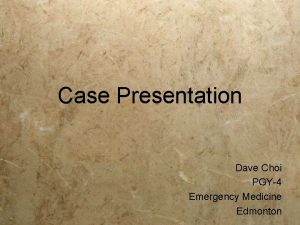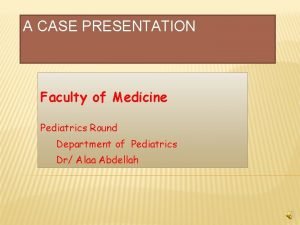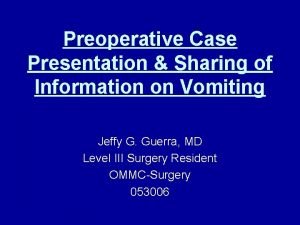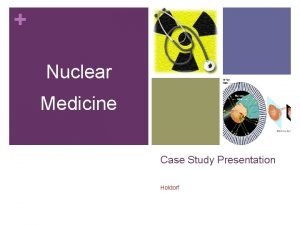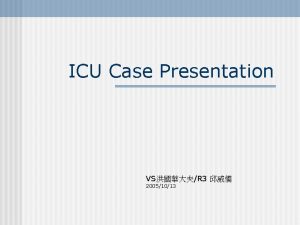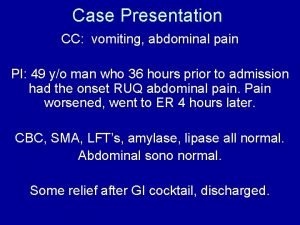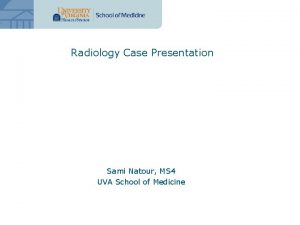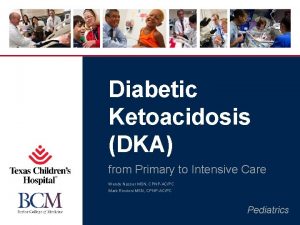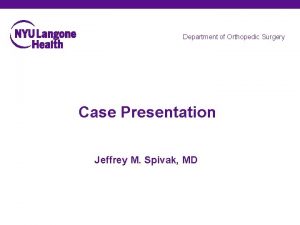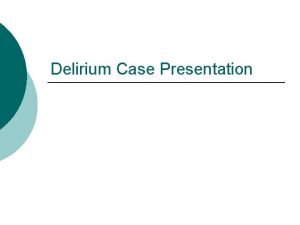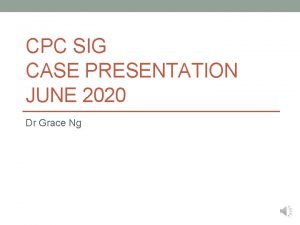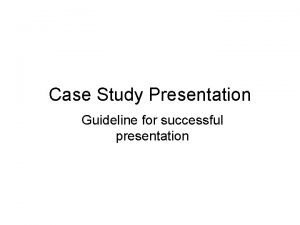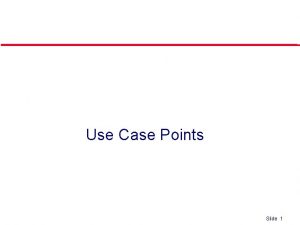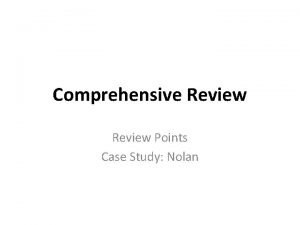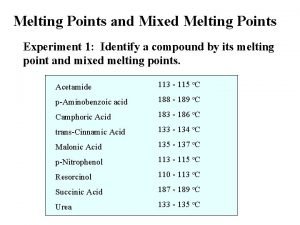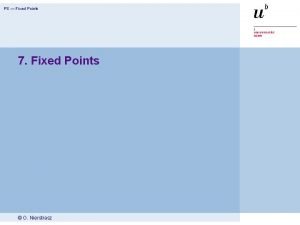CASE PRESENTATION Case Points from case When to


























- Slides: 26

CASE PRESENTATION

Case � Points from case �? When to give Epi pen to patients with allergic Rxn’s/ angioedema � Documentation ( how to RTN to ER ? ) � Admission criteria for allergic Rxn’s ( wouldn’t help with this case) � Beware bowel edema as manifestation of allergic Rxn � Earlier airway intervention ? surgical

Case

Intubate That!!!

Angioedema � Angioedema is characterized by painless, nonpruritic, nonpitting, and well-circumscribed areas of edema due to increased vascular permeability

Angioedema- Location � most apparent in the head and neck, including the face, lips, floor of the mouth, tongue, and larynx, but edema may involve any portion of the body � may involve the gastrointestinal tract, leading to intestinal wall edema

Angioedema

Angioedema- Pathophysiology � This deficiency in functioning C 1 -INH leads to autoactivation of the complement system and release of kininlike mediators, resulting in edema of the subcutaneous or submucosal tissues C’ Pathway (-) C 1 -INH (-) kallikrein high molecular weight–kinogen bradykinin

Angioedema - Classification � � 1) Hereditary angioedema (HAE) 2) Acquired angioedema (AAE) 3) Angioedema associated with allergic reactions (which is often associated with urticaria) 4) Angioedema secondary to medications � ACE � / ARB 5) Idiopathic angioedema

Angioedema- HAE � C 1 Esterase Inhibitor Deficiency � 3 Types � 1) Low levels of C 1 -INH (80 -85%) � 2) Normal Levels but dysfunctional � 3) Normal levels and function – only women? X-linked dominant inheritance

Angioedema � Precipitants of HAE angioedema � Mental and physical stress � Trauma � Dental or surgical procedures � Infections � Menstruation � Pregnancy � Oral contraceptives containing estrogens

HAE- Treatment � � Epinephrine, corticosteroids, and antihistamines are NOT effective in patients with HAE, AAE, and ACE inhibitor–induced angioedema. These agents are recommended as secondline therapy. (in cases of angioedema due to allergic causes, these medications are first-line therapies. )

HAE - Treatment � 1 st line treatment � Vapor-heated C 1 -INH concentrate (500 -2000 U IV) � FFP ( may worsen attack? ) 2 U IV � Other tranexamic acid epsilon-aminocaproic acid ( inhibit plasmin – plays role in initiating C’ cascade)

Angioedema - Classification � � 1) Hereditary angioedema (HAE) 2) Acquired angioedema (AAE) 3) Angioedema associated with allergic reactions (which is often associated with urticaria) 4) Angioedema secondary to medications � ACE � / ARB 5) Idiopathic angioedema

Angioedema- AAE � Rare � Type I – lymphomas / lymphoproliferative dz � Type II - autoantibodies ? cause

Angioedema - Classification � � 1) Hereditary angioedema (HAE) 2) Acquired angioedema (AAE) 3) Angioedema associated with allergic reactions (which is often associated with urticaria) 4) Angioedema secondary to medications � ACE � / ARB 5) Idiopathic angioedema

Angioedema – Allergy Induced � Allergy-induced angioedema � � an Ig. E-mediated hypersensitivity reaction Causes � Medications � Food � Environmental allergens (insect bites)

Angioedema – Anaphylaxis / Treatment (Level of Evidence)

Angioedema – Anaphylaxis / Treatment (Level of Evidence)

Anaphylaxis – Drug Therapy � Vasopressin ( Level C) � 4 U bolus � 10 U diluted in 10 mls ( titrate to effect) � Surviving Sepsis Campaign guidelines � Recommend an AVP dosage of 0. 03– 0. 04 IU/min, a recent study suggested that 0. 067 IU/min (4 IU/h)

Angioedema - Classification � � 1) Hereditary angioedema (HAE) 2) Acquired angioedema (AAE) 3) Angioedema associated with allergic reactions (which is often associated with urticaria) 4) Angioedema secondary to medications � ACE � / ARB 5) Idiopathic angioedema

Angioedema- ACE Inhibitors

Angioedema � � 0. 1 -0. 2% of patients treated with ACE inhibitors develop angioedema Idiosyncratic Rxn � 14 fold increased risk in first month of treatment � Has occurred >1 yr after initiation

Angioedema- Emerg Facts � � � 94% of angioedemas in ED due to meds Most of these due to ACE Inhibitors As many as 22 % require intubation 11% mortality ARB’s also cause but incidence unknown (case reports) � Mainly losarten

Angioedema- Predictors � Airway Intervention (Zirkle et al 2000) � Increasing age � Symptoms ( eg. stridor, hoarseness, dyspnea) � Not correlated � Rapidity of onset of sx � Cause of angioedema � Gender � Previous history

Angioedema- Airway � Preferred techniques � Awake nasotracheal ( orotracheal ) � Cricothyrotomy � Tracheostomy
 Brand positioning bulls eye
Brand positioning bulls eye Points of parity and points of difference
Points of parity and points of difference Best case worst case average case
Best case worst case average case Brow presentation birth
Brow presentation birth Leopold's maneuver
Leopold's maneuver Yelp case study presentation
Yelp case study presentation Private equity case study presentation
Private equity case study presentation Yelp vision
Yelp vision Malnutrition case
Malnutrition case Business case presentation template
Business case presentation template Emergency medicine case presentation
Emergency medicine case presentation Hemophilia transmission
Hemophilia transmission Gastric outlet obstruction differential diagnosis
Gastric outlet obstruction differential diagnosis Case presentation introduction
Case presentation introduction Icu case presentation
Icu case presentation Icu case presentation
Icu case presentation Wpvr-230
Wpvr-230 Vomiting case presentation
Vomiting case presentation Sami natour
Sami natour Dka case presentation ppt
Dka case presentation ppt Orthopedic case presentation
Orthopedic case presentation Orthopedic case presentation
Orthopedic case presentation Delirium case presentation
Delirium case presentation Cpc case presentation
Cpc case presentation Case study presentation guidelines
Case study presentation guidelines Gbs case presentation
Gbs case presentation Jaundice case presentation
Jaundice case presentation










